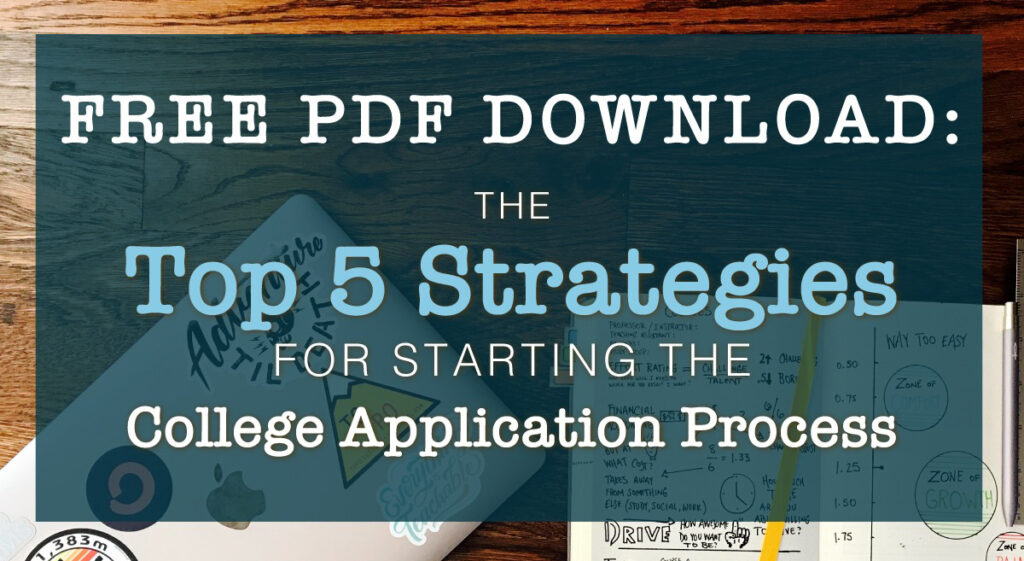Have you ever noticed that the college admissions process is filled with acronyms and unfamiliar terms? Sometimes it feels like another language. It isn’t easy to figure out what you are supposed to do if you can’t even determine what it all means. Below is a list of common college admissions terms. This list will help you learn the college admissions lingo and start your college process with confidence!
Standardized Testing
Standardized testing is used in college admissions to establish a common “standard” for comparing applicants. Most colleges and universities are test-optional, so applicants must carefully review each school’s standardized testing policies to determine their testing strategy.
The ACT is a standardized test administered through ACT.org. The Classic ACT has four sections: English, Math, Reading, and Science. The new Core ACT, offered in April 2025, will include English, Math, and Reading, with the science section optional. Each section is scored on a scale from 1 to 36. Scores are averaged to create a composite score.
The PSAT/NMSQT is the Preliminary SAT/National Merit Scholarship Qualifying Test. It is often taken during the 10th and 11th grades. Students who achieve a high score in the 11th grade could qualify for the National Merit Scholarship Program. Although the PSAT scoring is complex, it provides a “predicted” SAT score.
The SAT is a standardized test administered by the College Board. It has two sections: math and evidence-based reading and writing. Scores for both sections range from 200 to 800.
SAT Score Choice is the College Board’s practice of allowing students to choose which SAT scores (taken on different days) are sent to colleges.
Superscoring is when a college or university considers the highest section scores across all the dates a student took an exam. Many colleges will superscore the SAT, but some will not superscore the ACT.
Test-optional refers to a college or university policy that allows students to submit standardized test scores or not, without affecting their application status. Some schools do not require an SAT or ACT for admission, but they require test scores for a student to be considered for scholarships. Some colleges are also test-flexible, giving students options regarding which test scores (or sections of tests) to submit for consideration. You may also hear the term “test blind” or “test free,” meaning the college or university will not consider scores for any applicant. Visit the website: https://fairtest.org/test-optional/ for the most up-to-date list of test-optional schools.
Application Process
As students prepare their college applications, it is essential that they understand the terms used. This will help them determine the best strategy for completing their applications, including how and when to apply.
The Common Application platform is used by more than 1,100 colleges and universities. Students can complete one application and submit it to several schools. Many schools require students to complete a supplemental section, which allows the college or university to ask school-specific questions, including additional writing prompts.
Coalition Application is an application platform created by the Coalition for Access, Affordability, and Success. It has over 170 members. In addition to serving as an application platform, MyCoalition provides students with tools to prepare for the college application process.
A Deferred decision occurs when a student submits an early application, but the college determines it cannot make a decision in the early round. The application is then deferred and considered with the regular admission pool.
Demonstrated Interest is how an applicant shows that they are genuinely interested in attending the school. Students can indicate interest by visiting the campus, communicating with an admissions officer, or following a college on social media. Some schools do not track demonstrated interest, while others do consider it when making admissions decisions.
Early Action (EA) is similar to the Early Decision option. However, the student is not obligated to attend the university. Students submit EA applications in November or December, and decisions are typically released in December or January. Applicants have until May 1st to notify colleges of their intent to enroll.
Early Decision (ED) is a binding application option in which a student applies to a college or university and commits to attending if admitted. Students usually submit ED applications by November 1st or November 15th. Some colleges offer an early decision 2 option with deadlines in January.
A high School Profile is a document often submitted to colleges by a high school counselor with the student’s transcript. It provides colleges with an overview of the course offerings, grading scale, and average standardized test scores. Colleges use this information to review the student’s transcript in the context of their learning environment.
Regular Decision is an application option in which students submit applications in January or later. Decisions are often released in mid-to-late March. Applicants have until May 1st to notify colleges of their intent to enroll.
Priority Deadlines encourage applicants to submit applications by a specific deadline. Colleges often do not guarantee that they will have available admissions space or scholarships after the priority deadline.
Rolling Admission is a process in which a college or university accepts applications and releases decisions continuously. Some colleges with rolling admissions do have priority deadlines.
Single-Choice Early Action or Restrictive Early Action is an application that restricts students from submitting early action or early decision applications to other schools. Applications submitted under this option are non-binding; however, students must carefully review the REA or single-choice application policies to determine their application plan for the other schools to which they will apply.
Spring Admission is when a college or university admits students but allows them to enroll only in the spring semester. It is a common practice used to help schools control enrollment numbers.
A Waitlist offer is an application decision in which students are reconsidered for admission if the college or university does not meet their enrollment numbers after the May 1st deposit deadline. Students must send an enrollment deposit to another institution by May 1st. If they are accepted from the waitlist, they may withdraw this deposit.
Yield is the percentage of applicants offered admission to a college or university who ultimately enroll.
College Cost
Figuring out how to pay for college begins with understanding how financial aid works and the total cost of attending. While only some students will apply for financial aid, they should still know what they are paying for.
The Cost of Attendance (COA) is the estimated total cost for a student to attend a college or university for one year. It includes tuition and fees, on-campus room and board, and estimates of additional expenses (such as books and transportation).
The CSS Profile is a financial aid form required by some colleges, primarily private institutions, to be considered for institutional aid. The CSS Profile asks detailed questions about a family’s finances. Students should submit their profiles by the college or university’s stated deadlines, which are usually the same as the admissions application deadline. The College Board administers the CSS Profile.
Free Application for Federal Student Aid (FAFSA) is an application that helps colleges determine a student’s financial needs and how much federal aid a student receives. The online application can be found at www.fafsa.gov, which becomes available on October 1st of their senior year.
Merit-based aid and Scholarships are given directly to the student by the college or university. Usually, students receive merit money if they are near the top of the average admitted student profile. Some institutions, including all Ivy League schools and many selective small liberal arts colleges, do not offer merit scholarships. Their financial aid programs are solely need-based.
Outside Scholarships are offered by organizations other than the government or a college or university. It can be from a large corporation or a small non-profit. Most outside scholarships do require an application.
Need-blind or need-aware Admission occurs when a college or university considers a student’s financial situation when making an admissions decision. Need-blind colleges do not consider a student’s financial situation, while need-aware colleges do.
Need more direction for your college process? Check out the Ideal College Planning Timeline to get started!
Photo by Paul Schafer on Unsplash


